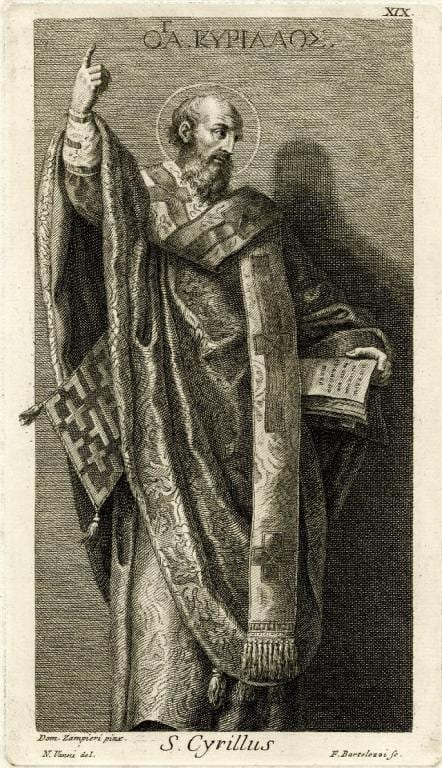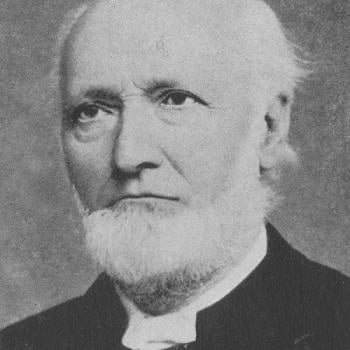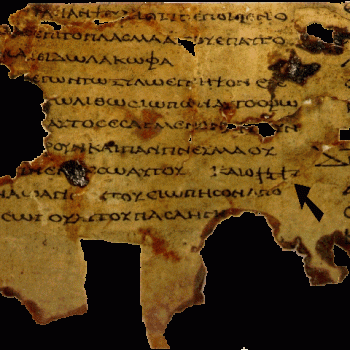
Sources I will be critiquing:
“Did the Church Fathers Practice Communion in the Hand? (Not Exactly)” (Dr. Taylor Marshall, TaylorMarshall.com, 1-7-11) [green font]
“Debunking the myth that today’s Communion in the hand revives an ancient custom” (Dr. Peter Kwasniewski, Lifesite News, 11-26-19) [blue]
21. In approaching therefore, come not with your wrists extended, or your fingers spread; but make your left hand a throne for the right, as for that which is to receive a King. And having hollowed your palm, receive the Body of Christ, saying over it, Amen. So then after having carefully hallowed your eyes by the touch of the Holy Body, partake of it; giving heed lest you lose any portion thereof; for whatever you lose, is evidently a loss to you as it were from one of your own members. For tell me, if any one gave you grains of gold, would you not hold them with all carefulness, being on your guard against losing any of them, and suffering loss? Will you not then much more carefully keep watch, that not a crumb fall from you of what is more precious than gold and precious stones?
22. Then after you have partaken of the Body of Christ, draw near also to the Cup of His Blood; not stretching forth your hands, but bending, and saying with an air of worship and reverence, Amen, hallow yourself by partaking also of the Blood of Christ. And while the moisture is still upon your lips, touch it with your hands, and hallow your eyes and brow and the other organs of sense. Then wait for the prayer, and give thanks unto God, who has accounted you worthy of so great mysteries. (St. Cyril of Jerusalem [c. 313-386], Catechetical Lectures, 23:21-22)
§ 2. Authenticity of the Lectures. The internal evidence of the time and place at which the Lectures were delivered has been already discussed in chapters viii. and ix., and proves beyond doubt that they must have been composed at Jerusalem in the middle of the fourth century. At that date Cyril was the only person living in Jerusalem who is mentioned by the Ecclesiastical Historians as an author of Catechetical Lectures: and S. Jerome, a younger contemporary of Cyril, expressly mentions the Lectures which Cyril had written in his youth. In fact their authenticity seems never to have been doubted before the seventeenth century, when it was attacked with more zeal than success by two French Protestant Theologians of strongly Calvinistic opinions, Andrew Rivet (Critic. Sacr. Lib. iii. cap. 8, Genev. 1640), and Edmund Aubertin (De Sacramento Eucharistiæ, Lib. ii. p. 422, Ed. Davent., 1654). Their objections, which were reprinted at full length by Milles at the end of his Edition, were directed chiefly against the Mystagogic Lectures, and rested on dogmatic rather than on critical grounds. . . .*That John, Cyril’s successor, did deliver Catechetical Lectures, we know from his own correspondence with Jerome: and this very circumstance may account for his name having been associated with, or substituted for that of Cyril.*
To Rivet’s objection Milles makes answer that if the mistakes of a transcriber or the stumbling of an ignorant Librarian (imperiti Librarii cæspitationes) have in one or two MSS. ascribed the Lectures to John or any one else, this cannot be set against the testimony of those who lived nearest to the time when the Lectures were composed, as Jerome and Theodoret. Also the internal evidence proves that the Lectures could not have been delivered later than the middle of the fourth century, whereas John succeeded Cyril about 386.
Moreover it is quite impossible to assign the two sets of Lectures to different authors. In Cat. xviii. § 33 the author promises, as we have seen, that he will fully explain the Sacramental Mysteries in other Lectures to be given in Easter week, in the Holy Sepulchre itself, and describes the subject of each Lecture; to which description the Mystagogic Lectures correspond in all particulars. Other promises of future explanations are given in Cat. xiii. § 19, and xvi. § 26, and fulfilled in Myst. iv. § 3, and ii. § 6, and iii. § i. On the other hand the author of Myst. i. § 9, after quoting the words, “I believe in the Father, and in the Son, and in the Holy Ghost, and in one Baptism of repentance,” adds, “Of which things I spoke to thee at length in the former Lectures.”
By these and many other arguments drawn from internal evidence Touttée has shewn convincingly that all the Lectures must have had the same author, and that he could be no other than Cyril.
§ 3. Early Testimony. Under the title “Veterum Testimonia de S. Cyrillo Hierosolymitano ejusque Scriptis,” Milles collected a large number of passages bearing on the life and writings of S. Cyril, of which it will be sufficient to quote a few which refer expressly to his Lectures.
S. Jerome, in his Book of Illustrious Men, or Catalogue of Ecclesiastical Writers, composed at Bethlehem about six years after Cyril’s death, writes in Chapter 112: “Cyril, Bishop of Jerusalem, having been often driven out from the Church, afterwards in the reign of Theodosius held his Bishopric undisturbed for eight years: by whom there are Catechetical Lectures, which he composed in his youth.”
Theodoret, born six or seven years after the death of Cyril, in his Dialogues (p. 211 in this Series) gives the “Testimony of Cyril, Bishop of Jerusalem, from his fourth Catechetical Oration concerning the ten dogmas. Of the birth from a virgin, “Believe thou this, &c.” . . .
Gelasius, Pope 492, De duabus in Christo naturis, quotes as from Gregory Nazianzen the words of Cyril, Cat. iv. § 9: Διπλοῦς ἦν ὁ Χριστός, κ.τ.λ.
Leontius Byzantinus (610 circ.) Contra Nestor. et Eutychem, Lib. 1. quotes the same passage expressly as taken “From the 4th Catechetical Oration of Cyril, Bishop of Jerusalem.”
Many other references to the Catecheses as the work of Cyril are given by Touttée, pp. 306–315.
Now, even if we grant the skeptical view (held apparently by a considerable number of scholars) that the last five lectures were actually written by Cyril’s successor, St. John, Bishop of Jerusalem (c. 356-417), where does that get the critics of communion in the hand: most of whom claim it has no ancient pedigree to speak of? Exactly nowhere . . . we still have a reputable witness to the practice, just a few years after St. Cyril. He describes the ritual.
So how — pray tell — does that help the reactionary “anti-hand” case? It doesn’t at all. They would somehow have to question his authenticity, too, or besmirch his character and trustworthiness as a witness. That would be a stretch, seeing that he is venerated by a saint, both by Catholics and Orthodox. Either way we look at it, the description of the actual liturgical practice is beyond dispute. And it documents what reactionaries want to fight against tooth and nail (as seen in the intense hostility of the titles of the four article above, that I am critiquing).
III. The Argument from Additional Elements in Cyril’s Description that Are Not Followed in Holy Communion Today
The “make your hand a throne” passage goes on to say that the faithful should touch the Holy Body of Christ to their eyes before consuming it. Then it also says that the faithful should touch their lips still moist with the precious Blood of Christ and touch the Blood to their eyes. . . . Yet who wants to argue for this custom?! I think that every Catholic would find this abhorrent. It is an aberration from holy tradition.
One should consider how during the sacred mysteries we take the limbs of the Spouse, kiss them, embrace them and apply them to our eyes.
Let us receive the Body of the crucified, and applying it to our eyes, our lips, and forehead, let us partake of the Divine burning coal.
1) We are examining whether Church fathers bear witness to the practice of x [x being communion in the hand].*2) We find some evidence of x [in fact, the evidence most cited] in St. Cyril of Jerusalem [or his successor, as the case may be].*3) But, x in this instance is also accompanied by currently non-observed liturgical ritual y.*4) Therefore, St. Cyril’s “testimony” of the existence of x is questionable or perhaps invalid (or a non sequitur) altogether, since y is also present.
1) In the early Church, even adult catechumens were baptized in the nude.*2) There was also a widespread practice of waiting until near death to be baptized.*3) Assigned penances were far more strict than they are today.*4) People often received Holy Communion far less frequently than today.
Other “secondary” or “accidental” or “non-required / non-essential” elements were also present (nude baptisms, baptisms delayed in the extreme, excessively harsh assignments of penance, and non-frequent communion). These external or secondary elements, however, do not wipe out or nullify the essence of the three sacraments.
In the same way, the presence of this additional Communion ritual, described by St. Cyril, doesn’t nullify or somehow make less relevant the part of the ritual that we follow today (receiving Holy Communion in the hand). Perhaps some analogies from sports will help explain:
1) Baseball banned the spitball after the 1920 season (with the exception of 17 existing spitball pitchers, who played all the way till 1934). This pitch had been thrown along with the standard fastball and curveball and other pitches (screwball, knuckleball, etc.).*2) Therefore, the fastball and curveball are not part of legitimate baseball “tradition”, since the spitball no longer is.*3) Therefore, baseball is essentially a different game than it was before 1921.
1) The three-point field goal was introduced to the NBA in 1979.
2) Therefore, the NBA was not actually the NBA, nor basketball the same game, up to the year 1978.
Again, the conclusion doesn’t follow logically, because we acknowledge that sports can develop and change without affecting their essence. The essence of the game of basketball is getting the basketball through the hoop, to score points (more than the other team does). That was always there. A three-point shot (like the spitball) is merely a secondary, non-essential development.
By analogy, then, the fact that further Communion rituals were noted by St. Cyril, has no bearing whatsoever on his testimony to the essential, central ancient liturgical tradition that we still follow today. Assuredly, there were also simultaneous traditions of Holy Communion in the mouth (that, for example, Pope St. Leo the Great and Pope St. Gregory the Great bore witness to). But it doesn’t follow that the practice of communion in the hand was not legitimate liturgical tradition, or not followed by many. These can vary to some extent: as seen, for instance, in the 23 liturgical rites of the Eastern Catholic churches (where Holy Communion is received standing, not kneeling). The essence of all of them (including what St. Cyril described) is receiving Our Lord Body, Blood, Soul, and Divinity, in Holy Communion.
[I]f we look more carefully at what Cyril describes, and combine this passage with other hints from antiquity, we can see that even when Communion in the hand was practiced, it involved marks of reverence that (curiously?) never accompanied its re-invention in the late 1960s. In a forthcoming book, professor of Patristics Michael Fiedrowicz observes, concerning this passage:
It is significant that the Eucharist, laid on the right hand, is not then received by means of the less-valued left hand, but rather directly by the mouth. What appears at first glance to be communion in the hand reveals itself on closer examination to be communion in the mouth, with the right hand serving as a sort of paten. Bishop Cyril’s description shows that the attitude of the communicant is, then, not one of taking and capturing, but rather of reverent and humble reception, accompanied by a sign of adoration.
In his bestselling interview Christus Vincit: Christ’s Triumph over the Darkness of the Age, Bishop Athanasius Schneider — who, like Fiedrowicz, is a specialist in Patrology — goes into greater detail about the ancient ritual:
[T]he practice had a different form in ancient times than it does today: the Holy Eucharist was received on the palm of the right hand and the faithful were not allowed to touch the Holy Host with their fingers, but they had to bow down their head to the palm of the hand and take the Sacrament directly with their mouth, thus, in a position of a profound bow and not standing upright. The common practice today is to receive the Eucharist standing upright, taking it with the left hand.
The elements were placed in the hands (not in the mouth) of each communicant by the clergy who were present, or, according to Justin, by the deacons alone, amid singing of psalms by the congregation (Psalm 34), with the words: “The body of Christ;” “The blood of Christ, the cup of life;” to each of which the recipient responded “Amen.” (eminent Church historian Philip Schaff, History of the Christian Church: Ante-Nicene Christianity: A.D. 100-325 [Vol. II], Grand Rapids, Michigan: Eerdmans, 1976, from fifth edition of 1889, Chapter Five: “Christian Worship”: § 68. Celebration of the Eucharist, 238-239)
That, in the early Church, the faithful stood when receiving into their hands the consecrated particle can hardly be questioned. . . . St. Dionysius of Alexandria [d. 265], writing to one of the popes of his time, speaks emphatically of “one who has stood by the table and has extended his hand to receive the Holy Food” (Eusebius [263-339], Hist. Eccl., VII, ix). The custom of placing the Sacred Particle in the mouth, rather than in the hand of the communicant, dates in Rome from the sixth, and in Gaul from the ninth century (Van der Stappen, IV, 227; cf. St. Greg., Dial., I, III, c. iii). (Catholic Encyclopedia: “Genuflexion”)
*Tell me, would you choose to come to the Sacrifice with unwashen hands? No, I suppose, not. . . . And yet the hands hold it but for a time, whereas into the soul it is dissolved entirely. (St. John Chrysostom [c. 349-407], Homily 3 on Ephesians)*Distribution of the bread and wine took place at the chancel rail, where the people came forward to stand and receive from the hands of the bishop and/or deacons. Bread was placed into the joined hands with the words, ‘The Body of Christ,’ to which the recipient responded: ‘Amen’ . . . The cup was offered to each by another minister, with a similar exchange. (from Augustine Through the Ages: An Encyclopedia, general editor: Allan D. Fitzgerald, Grand Rapids, Michigan: Wm. B Eerdmans Pub. Co., 1999; “Eucharistic Liturgy,” p. 338; this article written by Robin M. Jensen and J. Patout Burns)
. . . in whose hands you placed the Eucharist, to whom in turn you extended your hands to receive it . . . (St. Augustine [354-430], Against Petilian the Donatist book 2 ch 23 par 53)
And although the men are not one who take in hand the sacrament of God worthily or unworthily, yet that which is taken in hand, whether worthily or unworthily, is the same; so that it does not become better or worse in itself, but only turns to the life or death of those who handle it in either case. (St. Augustine, Against Petilian the Donatist book 2 par 88)
*
St. Caesarius of Arles (c. 470-542), in his Sermon 227, noted that men received Holy Communion on the hand, and women, on their hand covered with a veil (Omnes viri, quando communicare desiderant, lavant manus suas; et omnes mulieres nitida exhibeant linteamina, ubi corpus Christi accipiant). Synods in Gaul in the 6th-7th centuries confirm the same practice.
*
Wherefore, if any one wishes to be a participator of the immaculate Body in the time of the Synaxis, and to offer himself for the communion, let him draw near, arranging his hands in the form of a cross, and so let him receive the communion of grace. (Council of Constantinople, Trullo Canon 101, [692 AD] )*“Nevertheless,” said he, “bring me the Eucharist.” Having received It into his hand, . . . (Venerable Bede [672-735], Ecclesiastical History of England, Book 4, ch 24)*Let us draw near to it with an ardent desire, and with our hands held in the form of the cross let us receive the body of the Crucified One: . . . (St. John Damascene [676-749], An Exposition of the Orthodox Faith, Book IV, Chapter 13)*Such vessels in the first centuries were used in the service of the altar, and probably served to collect the offerings of bread made by the faithful and also to distribute the consecrated fragments which, after the loaf had been broken by the celebrant, were brought down to the communicants, who in their own hands received each a portion from the patina. . . .When towards the ninth century the zeal of the faithful regarding the frequent reception of Holy Communion very much declined, the system of consecrating the bread offered by the faithful and of distributing Communion from the patinæ seems gradually to have changed, . . . (Catholic Encyclopedia, [Herbert Thurston], “Paten”)













